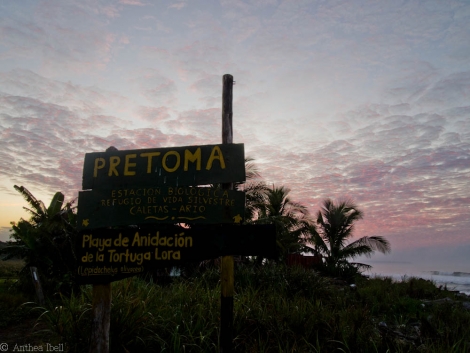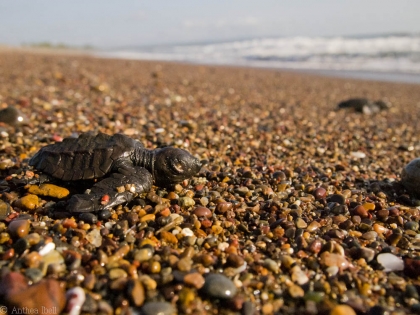After a dusty bus ride from the capital of Costa Rica to San Francisco de Coyote, I was picked up by Erick Lopez of Pretoma. Pretoma is a non-profit that was set up in 1997 with the aim to preserve Costa Rica’s marine wildlife through research and conservation. Pretoma also works to promote sustainable fishing in Costa Rica and throughout Central America.
There are four species of sea turtles that nest on the beaches of Costa Rica’s pacific coast; the Olive Ridley, Hawksbill, Pacific Green and Eastern Pacific Leatherback. In 2006 the Costa Rican government introduced the Playa Caletas-Ario National Wildlife Refuge which covers 7km of beach and also spans 12miles offshore at Caletas on the Nicoya Peninsular. The refuge prohibits poaching, trawling and scuba fishing. A camp was built on the beach that is home to volunteers. I spent a few days here during my visit to learn more about the turtles. My first night I went on ‘patrol’ with Nicole White the volunteer coordinator. The patrol shift entails walking either North or South from the camp along the beach looking for female turtle tracks as they come ashore to nest. Within half an hour we stumbled upon the tractor like paths in the sand – following them up the beach we found the neatly patted down nest. The female probably recently returned to the sea but often the volunteers find the female nesting. I was provided the honour of digging into the nest and recovering the eggs; ping-pong sized soft, white, gooey spheres. The eggs are quite tough for the first 12-24hours until the yolk becomes set and they become very fragile. We placed the eggs in a bag and continued the patrol. We returned to the camp with the one nest’s loot and buried them in a quadrant in the hatchery. The hatchery provides protection from natural predators as well as poachers who also patrol the beaches. The eggs we had gathered were Olive Ridley turtle eggs which fetch 4 for $1 on the pet market – a tragic thought for hatchlings of a vulnerable species.
Later that night I worked a Hatchery shift. The hatchlings emerge under the cover of night to gain some refuge from daytime predators such as birds and also protection for the sensitive animals from the harsh sunlight. In the hatchery the expecting nests are monitored throughout the night and as the small hatchlings emerge they are counted and taken down to the waterfront 30m away. They are placed on the stony beach and crawl their way into the breakers. This ‘imprint’ on the beach is crucial for the turtles to get the hang of their flippers and set their internal GPS so they know where to return when the females come back to nest. It was an incredible experience to watch the tiny turtles flipping their way into the waves at sunrise.
During my last night at Caletas, a group of us left the camp to patrol. Nicole recognised hatchling tracks in the sand and we had arrived just after Leatherback hatchlings had entered the ocean! She exhumed the nest to check for any stragglers and to assess the remaining eggs. There were 80 viable eggs in the clutch and many infertile eggs that are possibly used for temperature control and decoys for predators. Of the 80 fertile eggs; 13 tracks showed that they made it to the water and we found two hatchlings still in the nest. Leatherbacks nest at Caletas but this season only two clutches were found and relocated to the hatchery. It was incredible luck to find the natural nest on the beach!
Volunteers work night shifts at the sanctuary throughout the nesting season from July to March. With the protection from the Caletas volunteers the hatchlings have an increased chance of survival before they make it to the ocean, but once they are in the big Pacific their chances completely change. All sea turtles have an estimated 1 in 1,000 chance of survival!
A big thank you to Erick Lopez and Nicole White from Pretoma for making my visit an experience to remember!















